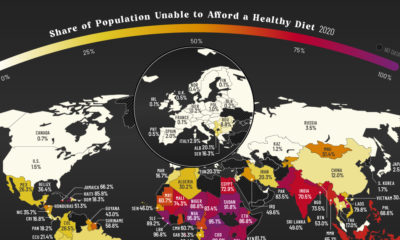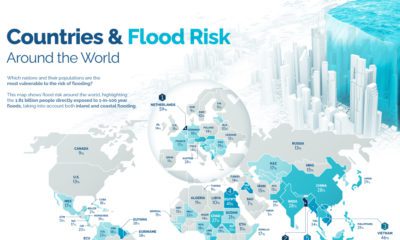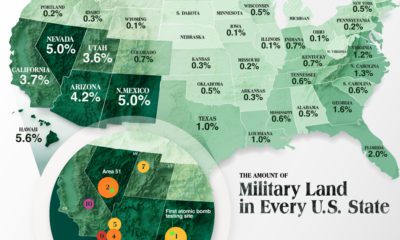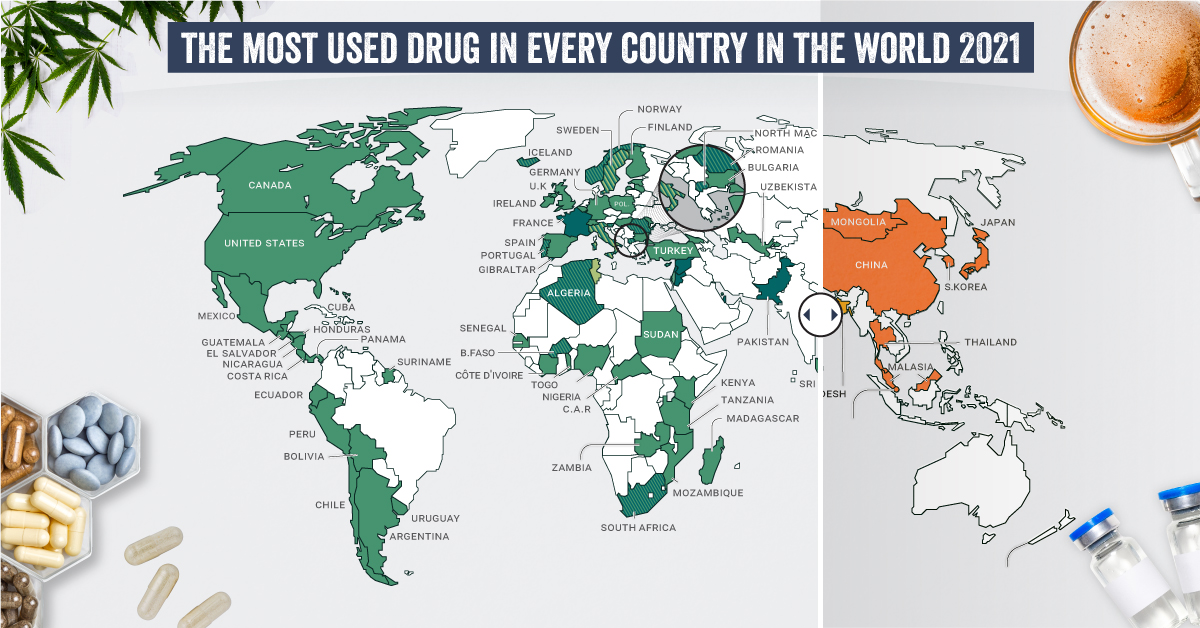Since the early 20th century, the use of cannabis for any purpose fell out of favor by both regulators and Western culture at large. In the United States, a wave of regulations made access to cannabis more difficult starting from the late 1900s, ultimately culminating in the Marihuana Tax Act of 1937, which effectively made cannabis use a federal offense. Meanwhile, prohibition in Canada lasted for 85 years until being lifted by recent developments. Interestingly, however, this recent period of 20th century opposition is actually just a small speck in the wider 6,000-year timeline of cannabis. After all, the plant has been widely regarded for its therapeutic potential for many millennia by different cultures around the world.
6,000 Years of Medical Cannabis
Today’s infographic comes to us from MedReleaf, and it focuses on the medical uses of cannabis discovered by many cultures over time. With uses dating back to Ancient empires such as Rome, Egypt, and China, it helps to put into perspective recent legal and cultural developments regarding cannabis on a broader historical scale. 4000 BC: Pan-p’o village Cannabis was regarded among “five grains” in China, and was farmed as a major food crop. 2737 BC: Pen Ts’ao Ching Earliest record of cannabis as a medicinal drug. At this time, Emperor Shen-Nung recognized its treatment properties for over 100 ailments such as gout, rheumatism, and malaria. 2000-1400 BC: Scythians Nomadic Indo-European peoples used cannabis in steam baths, and also burned cannabis seeds in burial rituals. 2000-1000 BC: Atharva Vedas Cannabis was described as a “source of happiness”, “joy-giver”, and “bringer of freedom” in these Hindu religious texts. At this time, cannabis was smoked at daily devotional services and religious rituals. 2000-1000 BC: Ayurvedic Medicine Open religious use of cannabis allowed for exploration of medical benefits. During this period, it was used to treat a variety of ailments such as epilepsy, rabies, anxiety, and bronchitis. 1550 BC: Ebers Papyrus Egyptian medical papyrus of medical knowledge notes that medical cannabis can treat inflammation. 1213 BC: Ramesses II Cannabis pollen has been recovered from the mummy of Ramesses II, the Egyptian pharaoh who was mummified after his death in 1213 BC. 900 BC: Assyrians Employed the psychotropic effects of cannabis for recreational and medical purposes. 450-200 BC: Greco-Roman use Physician Dioscorides prescribed cannabis for toothaches and earaches. Greek doctor Claudius Galen noted it was widely consumed throughout the empire. Women of the Roman elite also used cannabis to alleviate labor pains. 207 AD: Hua T’o First recorded physician to describe cannabis as an analgesic. He used a mixture of cannabis and wine to anesthetize patients before surgery. 1000 AD: Treats Epilepsy Arabic scholars al-Mayusi and al-Badri regard cannabis as an effective treatment for epilepsy. 1025 AD: Avicenna The medieval Persian medical writer publishes “Avicenna’s Canon of Medicine”, stating that cannabis is an effective treatment for gout, edema, infectious wounds, and severe headaches. His work was widely studied from the 13th to 19th centuries, having a lasting impact on Western medicine. 1300 AD: Arab traders Arab traders bring cannabis from India to Eastern Africa, where it spreads inland. It is used to treat malaria, asthma, fever, and dysentery. 1500 AD: Spanish Conquest The Spanish brought cannabis to the Americas, where it was used for more practical purposes like rope or clothes. However, years later, it would be used as a psychoactive and medicinal drug. 1798: Napoleon Napoleon brought cannabis back to France from Egypt, and it was investigated for its pain relieving and sedative qualities. At this time, cannabis would be used to treat tumors, cough, and jaundice. 1839: William O’Shaughnessy Irish doctor William O’Shaughnessy introduced the therapeutic uses of cannabis to Western medicine. He concluded it had no negative medicinal effects, and the plant’s use in a pharmaceutical context would rapidly rise thereafter. 1900: Medical Cannabis Medical cannabis was used to treat nausea, rheumatism, and labor pain. At this point in time, it is available over-the-counter in medications such as “Piso’s cure” and “One day cough cure”. 1914: Harrison Act Drug use was declared a crime in the U.S., under the Harrison Narcotics Tax Act in 1914. 1937: Marihuana Tax Act The Marihuana Tax Act banned the use and sales of cannabis in the United States. 1964: Discovery of THC The molecular structure of THC, an active component of cannabis, was discovered and synthesized by Israeli chemist Dr. Raphael Mechoulam. 1970: Classified as Schedule 1 Drug Cannabis became categorized as a Schedule 1 Drug in the U.S., which limited further research into the plant. It was listed as having “no accepted medical use”. 1988: CBD Receptors Discovered The CBD1 and CBD2 cannabinoid receptors were discovered. Today, we know they are some of the most abundant neuroreceptors in the brain. 2000-2018: Medical cannabis legalization Governments, such as those of Canada and various states, begin to legalize cannabis for medical purposes from licensed producers. Recreational legalization quickly starts to follow. on Humans have a storied and complicated relationship with drugs. Defined as chemical substances that cause a change in our physiology or psychology, many drugs are taken medicinally or accepted culturally, like caffeine, nicotine, and alcohol. But many drugs—including medicines and non-medicinal substances taken as drugs—are taken recreationally and can be abused. Each country and people have their own relationship to drugs, with some embracing the use of specific substances while others shun them outright. What are the most common drugs that are considered generally illicit in different parts of the world? Today’s graphics use data from the UN’s World Drug Report 2021 to highlight the most prevalent drug used in each country.
What Types of Common Drugs Are Tracked?
The World Drug Report looks explicitly at the supply and demand of the international illegal drug market, not including commonly legal substances like caffeine and alcohol. Drugs are grouped by class and type, with six main types of drugs found as the most prevalent drugs worldwide.
Cannabis*: Drugs derived from cannabis, including hemp. This category includes marijuana (dried flowers), hashish (resin), and other for various other parts of the plant or derived oils. Cocaine: Drugs derived from the leaves of coca plants. Labeled as either cocaine salts for powder form or crack for cocaine processed with baking soda and water into rock form. Opioids: Includes opiates which are derived directly from the opium poppy plant, including morphine, codeine, and heroin, as well as synthetic alkaloids. Amphetamine-type Stimulants (ATS): Amphetamine and drugs derived from amphetamine, including meth (also known as speed), MDMA, and ecstasy. Sedatives and Tranquilizers: Includes other drugs whose main purpose is to reduce energy, excitement, or anxiety, as well as drugs used primarily to initiate or help with sleep (also called hypnotics). Solvents and Inhalants: Gases or chemicals that can cause intoxication but are not intended to be drugs, including fuels, glues, and other industrial substances.
The report also tracked the prevalence of hallucinogens—psychoactive drugs which strongly affect the mind and cause a “trip”—but no hallucinogens ranked as the most prevalent drug in any one country. *Editor’s note: Recreational cannabis is legal in five countries, and some non-federal jurisdictions (i.e. states). However, in the context of this report, it was included because it is still widely illicit in most countries globally.
The Most Prevalent Drug in Each Country
According to the report, 275 million people used drugs worldwide in 2020. Between the ages of 15–64, around 5.5% of the global population used drugs at least once. Many countries grouped different types of the same drug class together, and a few like Saudi Arabia and North Macedonia had multiple different drug types listed as the most prevalent. But across the board, cannabis was the most commonly prevalent drug used in 107 listed countries and territories: How prevalent is cannabis worldwide? 72 locations or more than two-thirds of those reporting listed cannabis as the most prevalent drug. Unsurprisingly these include countries that have legalized recreational cannabis: Canada, Georgia, Mexico, South Africa, and Uruguay.
How Common Are Opioids and Other Drugs?
Though the global prevalence of cannabis is unsurprising, especially as it becomes legalized and accepted in more countries, other drugs also have strong footholds. Opioids (14 locations) were the most prevalent drugs in the Middle-East, South and Central Asia, including in India and Iran. Notably, Afghanistan is the world’s largest producer of opium, supplying more than 90% of illicit heroin globally. Amphetamine-type drugs (9 locations) were the third-most common drugs overall, mainly in East Asia. Methamphetamine was the reported most prevalent drug in China, South Korea, and Japan, while amphetamine was only the most common drug in Bangladesh. However, it’s important to note that illicit drug usage is tough to track. Asian countries where cannabis is less frequently found (or reported) might understate its usage. At the same time, the opioid epidemic in the U.S. and Canada reflects high opioid usage in the West. As some drugs become more widespread and others face a renewed “war,” the landscape is certain to shift over the next few years.












